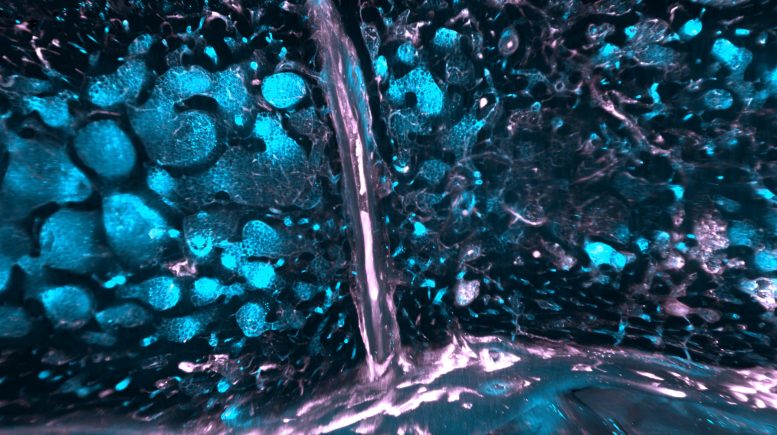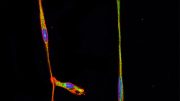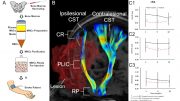
The image provides a captivating view of the intricacy and interconnectedness of the human skull. Through the use of advanced tissue-clearing techniques and imaging with a light sheet fluorescent microscope, the sample has been labeled to highlight myeloid immune cells (shown in cyan) and vessels (shown in pink). The skull bone marrow cavities are populated by myeloid immune cells, while the vessels create a complex network throughout the skull, showcasing the dynamic nature of this vital anatomical structure. Credit: Copyright Cell Press | ©Kolabas et al.
Neurological conditions such as Alzheimer’s, stroke, and multiple sclerosis can result in profound damage due to the neuroinflammation driven by immune cells. Treating this inflammation is challenging because the brain’s protective barriers, including the skull and surrounding membranes, hinder direct treatment access.
Previously, scientists identified pathways from the bone marrow of the skull leading to the brain, facilitating the movement of immune cells. Now, new research revealed that cells in the skull’s bone marrow are unique in their composition and in their disease response. These findings offer new possibilities for the diagnosis and treatment of neurological diseases and revolutionize brain health monitoring in the future with non-invasive skull imaging. The results were recently published in Cell.
Neurological diseases such as Alzheimer’s, stroke, and multiple sclerosis have a devastating impact on the lives of millions worldwide. A common feature is neuroinflammation, an internal “fire” in the brain that can cause severe damage by activation of immune cells and release of inflammatory molecules.
However, due to the brain’s relative inaccessibility, as it is shielded by the skull and three additional layers of protection in the form of membranes, controlling and monitoring this inflammation has been a major challenge. A team of scientists around Prof. Ali Ertürk at Helmholtz Munich in collaboration with researchers from the Ludwig-Maximilians-Universität München (LMU) and the Technical University of Munich (TUM) sought to address this unmet need.
Not Just a Helmet: The Intricate Connection Between the Skull and Brain
Defying the traditional understanding that the skull and the brain have no direct interchange, recent studies have unveiled direct connections between the skull’s bone marrow and the brain’s outermost surface of the protective membranes, the meningeal surface. These connections act as conduits, facilitating the movement of immune cells back and forth.
The team of scientists found that these connections often traverse even through the outermost and toughest layer of the membrane, the dura, opening up even closer to the brain surface than previously thought. To achieve these significant findings, the team utilized a specialized method called tissue clearing in combination with 3D imaging to visualize the conduits.
During the tissue-clearing process, biological tissues are treated with a specific solution to render them transparent enabling the passage of light for the examination of both brain tissue and the skull under a microscope. As a result, 3D images of structures and cells were generated, leading to a comprehensive visual analysis.
The research team probed even deeper into the distinct role the skull-based immune cells play in brain physiology and diseases. They began by questioning if the skull harbors unique brain-specific cells and molecules that cannot be found in other bones. Extensive analysis of the RNA and protein content in the form of transcriptomics and proteomics analyses of both mouse and human bones affirmed this – the skull is indeed exceptional, hosting unique neutrophil immune cells, which are a type of white blood cell that play a critical role in the immune system’s defense. “These findings carry profound implications, suggesting a far more complex connection between the skull and the brain than previously believed” highlights the first author of the study Ilgin Kolabas, Ph.D.-student at the Ertürk lab at Helmholtz Munich.
Ali Ertürk, corresponding author, adds: “This opens up a myriad of possibilities for diagnosing and treating brain diseases and has the potential to revolutionize our understanding of neurological diseases. This breakthrough could lead to more effective monitoring of conditions such as Alzheimer’s and stroke, and potentially even aid in preventing the onset of these diseases by enabling early detection.”
Envisioning a New Future: From Research to Clinical Practice
Another impactful finding was that using PET imaging, the researchers discovered that signals from the skull mirrored those from the underlying brain, with changes in these signals corresponding to disease progression in patients with Alzheimer’s and stroke. Thereby showcasing a new potential to monitor brain inflammation simply by scanning the surface of the patient’s head.
Looking forward, the researchers envision that their findings could translate to clinical practice in the form of non-invasive skull imaging. Ali Ertürk explains the impact on disease monitoring: “This could potentially be done using portable and wearable devices, offering a more accessible and practical way to monitor brain health”. The team hopes that this approach will greatly improve the diagnosis, monitoring, and possibly even treatment of neurological disorders, bringing us a step closer to more effective management of these devastating conditions.
Reference: “Distinct molecular profiles of skull bone marrow in health and neurological disorders” by Zeynep Ilgin Kolabas, Louis B. Kuemmerle, Robert Perneczky, Benjamin Förstera, Selin Ulukaya, Mayar Ali, Saketh Kapoor, Laura M. Bartos, Maren Büttner, Ozum Sehnaz Caliskan, Zhouyi Rong, Hongcheng Mai, Luciano Höher, Denise Jeridi, Muge Molbay, Igor Khalin, Ioannis K. Deligiannis, Moritz Negwer, Kenny Roberts, Alba Simats and Ali Erturk, 9 August 2023, Cell.
DOI: 10.1016/j.cell.2023.07.009








Be the first to comment on "Guardian of the Mind: The Surprising Role of the Skull in Brain Health"